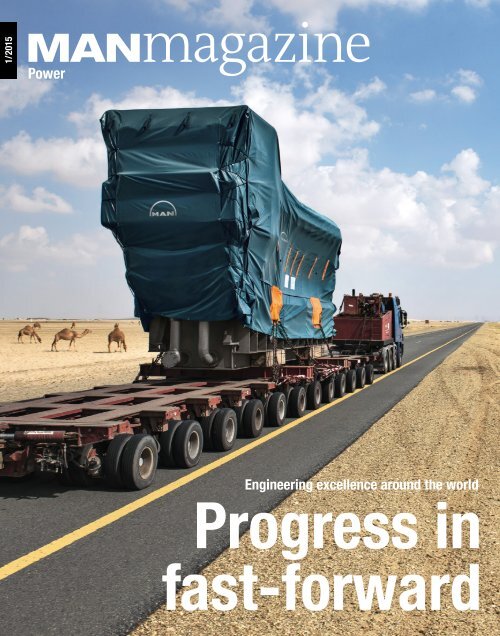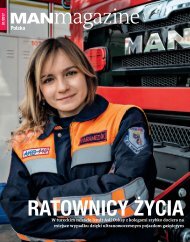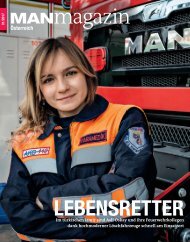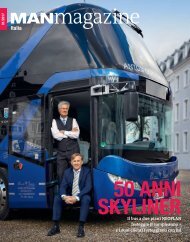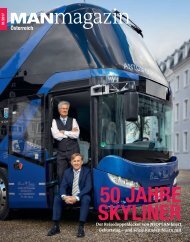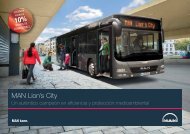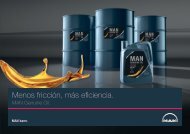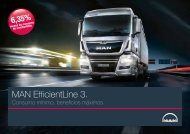MANmagazine Power 1/2015
With the MANmagazine by MAN Diesel & Turbo, we invite you to explore our universe of versatile technology. Join us on a world tour to Ecuador, Saudi Arabia, China and Switzerland to discover the fascinating and awe-inspiring details of cutting-edge power, marine and turbo applications.
With the MANmagazine by MAN Diesel & Turbo, we invite you to explore our universe of versatile technology. Join us on a world tour to Ecuador, Saudi Arabia, China and Switzerland to discover the fascinating and awe-inspiring details of cutting-edge power, marine and turbo applications.
Create successful ePaper yourself
Turn your PDF publications into a flip-book with our unique Google optimized e-Paper software.
1/<strong>2015</strong><br />
<strong>Power</strong><br />
Engineering excellence around the world<br />
Progress in<br />
fast-forward
man magazine<br />
1/<strong>2015</strong><br />
Welcome<br />
to the<br />
of MAN Diesel & Turbo.<br />
06<br />
content<br />
04 “My home is with the customer”<br />
MAN Diesel & Turbo’s new CEO shares<br />
his view on the company’s strategy and<br />
markets.<br />
<strong>Power</strong><br />
masthead<br />
MAN magazine is published three times a year<br />
in English.<br />
published by MAN Diesel & Turbo SE,<br />
Dr. Jan Dietrich Müller,<br />
Group Communications & Marketing<br />
Stadtbachstr. 1, 86153 Augsburg, Germany<br />
editors in chief Jan Hoppe, jan.hoppe@man.eu,<br />
Felix Brecht, felix.brecht@man.eu<br />
Publisher C3 Creative Code and Content GmbH,<br />
Heiligegeistkirchplatz 1, 10178 Berlin, Germany<br />
Tel.: +49 30 44032-0, www.c3.co,<br />
Shareholders of C3 Creative Code and Content GmbH<br />
are the Burda Gesellschaft mit beschränkter Haftung<br />
(limited liability company), Offenburg, and the KB<br />
Holding GmbH, Berlin, with 50% each. Sole shareholder<br />
of the Burda Gesellschaft mit beschränkter<br />
Haftung is the Hubert Burda Media Holding Kommanditgesellschaft<br />
(limited partnership), Offenburg.<br />
Shareholders of KB Holding GmbH are Mr. Lukas<br />
Kircher (managing director, Berlin) and Mr. Rainer<br />
Burkhardt (managing director, Berlin) with 50% each.<br />
Editors & Authors Cedric Arnaud (resp./C3<br />
Creative Code and Content GmbH, Arabellastraße 23,<br />
81925 Munich), David Barnwell, Hamish Mackenzie,<br />
Goeff Poulton, Patricia Preston, Vicki Sussens,<br />
Asa C. Tomash, Harry Waterstone<br />
project management Marlene Freiberger<br />
Graphics Micheline Pollach, Andrea Hüls<br />
Photo editor Elke Latinovic, André Kirsch<br />
Cover image Waleed Bin Talip<br />
productioN C3 Creative Code and Content GmbH<br />
printing Pinsker Druck und Medien GmbH<br />
Pinskerstraße 1, 84048 Mainburg, Germany<br />
reproduction permitted with reference.<br />
Any changes must be coordinated with the editors.<br />
Copyright ©<strong>2015</strong> MAN Diesel & Turbo<br />
and C3 Creative Code and Content GmbH<br />
14<br />
COVER STORY:<br />
In Saudi Arabia,an MAN<br />
Diesel & Turbo team works<br />
closely with the customer<br />
to provide power.<br />
08<br />
06 Up in thinner air<br />
Ecuador’s evolving economy relies on<br />
technology by MAN.<br />
08 Lighting up a brighter future<br />
Facing still-challenging conditions,<br />
Bangladesh is on the move.<br />
10 Modern getaways<br />
With MAN’s fuel-saving technology, NCL<br />
embarks on a new era of cruising.<br />
12 Testing the limits<br />
In Oberhausen, real-life assessments<br />
offer enhanced operation safety.<br />
14 Sand & power<br />
Building a complete power plant in the<br />
middle of the desert is a daunting task.<br />
MAN takes on the challenge.<br />
18 Two voices for one team<br />
MAN Diesel & Turbo and Fairbanks<br />
Morse join forces to tackle the world’s<br />
biggest gas market together.<br />
20 Gas giants<br />
Global LNG sourcing, transport and<br />
storage enters a new era.<br />
24 Smart savings<br />
The EcoCam retrofit solution enhances<br />
fuel usage for low-load operations.<br />
The best of the <strong>Power</strong> Engineering world<br />
With this first issue of <strong>MANmagazine</strong> by engineering solutions for a broad customer<br />
MAN Diesel & Turbo, we invite you to explore range almost anywhere on the planet, and in<br />
our universe of versatile technology. Join us on this publication, we strive to bring our readers<br />
a world tour to Ecuador, Saudi Arabia, China the most interesting, illuminating and useful<br />
and Switzerland to discover the fascinating topics and stories. We look forward to all of<br />
and awe-inspiring details of cutting-edge your feedback and hope you enjoy a good read.<br />
power, marine and turbo applications. As a<br />
global player and oftentimes market leader, Find a wide range of additional content<br />
MAN Diesel & Turbo provides high-end power online at > www.dieselturbo.man.eu<br />
All information provided in this magazine is intended<br />
for general guidance only and is not intended to be<br />
used as a substitute for specific technical or commercial<br />
information and advice.<br />
24<br />
26 Protecting profitability<br />
Optimized machinery trains increase<br />
efficiency at a mega PTA plant in China.<br />
30 Local hero<br />
A new generation of gas turbines offers<br />
flexible solutions worldwide.<br />
32 Boom or bubble?<br />
Where is the global shipping market<br />
moving? Two experts share their views.<br />
34 News<br />
Brief business updates from around the<br />
world<br />
35 Facts and figures<br />
Formidable insights and numbers<br />
02 03
man magazine 1/<strong>2015</strong><br />
Leading technology expert<br />
MAN Diesel & Turbo serves<br />
both a global and a diverse<br />
clientele. The company’s<br />
new CEO aims to further<br />
strengthen customer ties.<br />
Appointed to assume leadership<br />
of MAN Diesel & Turbo as of<br />
<strong>2015</strong>, Dr. Uwe Lauber embodies<br />
both an engineer with a passion<br />
for technological innovation<br />
as well as a staunch believer<br />
in customer orientation under any and all circumstances.<br />
<strong>MANmagazine</strong> conducted an<br />
interview to explore Lauber’s outlook and plans.<br />
Dr. Lauber, you were appointed Sales<br />
Director and CEO all in the same year. How<br />
do you tackle such a far-reaching transition?<br />
With tremendous motivation, but also<br />
a healthy measure of humility. I have respect<br />
for the tasks ahead of me and I am fully aware<br />
of the responsibility that the company has entrusted<br />
me with. After all, MAN has been successfully<br />
writing industrial history for more<br />
than 250 years. Yet more than anything else, I<br />
feel honored and I’m looking forward to the<br />
challenges in store. Considering the global positioning<br />
of our company, we must always remain<br />
in motion. So there’s a lot to do, and I’m<br />
confident that my Executive Board colleagues<br />
and I will continue to set the right course for<br />
the future.<br />
You have a reputation for believing in<br />
“uncompromising customer focus.” Would<br />
you agree? Our customers and the relationships<br />
with them are at the heart of everything<br />
we do and I am interested in implementing<br />
this paradigm to an even greater extent in<br />
our company. Therefore, both orders received<br />
as well as growth targets and trends are now<br />
bundled within a sales director position at the<br />
board level for the first time, which is<br />
my responsibility. Our partnerships with<br />
customers are therefore moving further into<br />
the spotlight, both from an organizational<br />
perspective and in the mind-sets of our<br />
“My home is<br />
where the<br />
customers are”<br />
Focused on the future: Dr. Uwe Lauber<br />
strives to reinforce the technological<br />
leadership role of MAN Diesel & Turbo.<br />
Photo: MAN<br />
employees. Among my primary tasks will<br />
be a continuously sharpened focus on MAN<br />
Diesel & Turbo’s entire portfolio of products<br />
and services and to promote our business beyond<br />
individual segments.<br />
How do you view the current economic<br />
situation and where are further growth opportunities<br />
for MAN Diesel & Turbo? Today’s<br />
economic climate is certainly challenging,<br />
but should actually encourage our company<br />
to do even better. The future holds vast<br />
potential, as MAN Diesel & Turbo plays a pioneering<br />
role in many sectors with regard to<br />
increased efficiency for its customers<br />
through technological advantages. Just one<br />
example is our new range of gas engines –<br />
excellent products with a strong unique selling<br />
point. The 51/60G is the most powerful<br />
engine available on the market today. I also<br />
feel confident about the Chinese market.<br />
Pipelines are under construction, and the infrastructure<br />
for liquid natural gas, or LNG, is<br />
being expanded. In the future, turbomachinery<br />
and engines will also be needed. Thus,<br />
natural gas will continue to play a major role<br />
in our business model. When converting gas<br />
– for example, in coal-to-liquid and gas-toliquid<br />
– we also have a unique product in the<br />
MAX1 compressor, which was designed especially<br />
for higher volume flows of higher performance<br />
density and increased effectiveness.<br />
Our competitors can rightly envy us.<br />
Professional profile<br />
Born in Bad Säckingen in Germany in 1967,<br />
Dr. Uwe Lauber obtained a master’s degree in<br />
mechanical engineering from the University of<br />
Applied Sciences in Konstanz and also studied<br />
business engineering at the business school<br />
in St. Gallen. In addition, he received a Ph.D.<br />
in mechanical engineering from the University<br />
of Kronstadt in 2009. After working at the<br />
company BOC Cryostar in different positions<br />
for more than nine years, he joined Sulzer<br />
Turbo – today MAN Diesel & Turbo – in 2000,<br />
where he was responsible for the design, R&D<br />
and testing of compressors. In December<br />
2010, he was appointed Head of the Oil & Gas<br />
business unit, as well as being named CEO of<br />
MAN Diesel & Turbo Schweiz AG. On October<br />
1, 2014, he joined the Executive Board of<br />
MAN Diesel & Turbo SE, responsible for the<br />
company’s global sales and after sales activities,<br />
including the Marine business.<br />
15<br />
years<br />
of MAN experience is part of Dr. Uwe<br />
Lauber’s vita. He became CEO of about<br />
14,000 employees on January 1, <strong>2015</strong>.<br />
You moved to MAN from Sulzer Turbo<br />
in 2000 and headed the Oil & Gas business<br />
unit. As your background is in turbomachinery,<br />
do you also harbor a passion for<br />
large diesel engines? I’m an engineer to the<br />
core, and whether I walk through the production<br />
bays in Augsburg, Oberhausen, Zurich,<br />
St. Nazaire, Deggendorf, Ravensburg, Berlin,<br />
Hamburg or Changzhou, the giant MAN-made<br />
machinery and engines never fail to impress<br />
and inspire me. It fills me with pride. Indeed,<br />
turbomachinery is the technological area that<br />
I’m most familiar with, so I spent weeks prior<br />
to my new assignment to introduce myself to<br />
colleagues at numerous locations, become<br />
better acquainted and seek dialogue with employees<br />
on site. It was a marvelous experience,<br />
and I encountered many dedicated and talented<br />
people who are tremendously committed<br />
to the company.<br />
Can you outline what you value most<br />
about MAN Diesel & Turbo as a company?<br />
Besides a product range that can quicken the<br />
pulse of any engineer, I’m also proud of the<br />
fact that MAN is part of the Volkswagen<br />
Group. We are a long-established company<br />
within a global organization and need to further<br />
utilize the effectiveness and strength of<br />
two powerful brands.<br />
So far, Zurich has been your base, yet<br />
your new role takes you to Augsburg. Will<br />
you relocate? While I don’t plan to move my<br />
family at the moment, I have taken a small<br />
flat in Augsburg. Even though I am CEO, I still<br />
remain the board member in charge of sales,<br />
and that primarily means interaction with<br />
customers. Sales executives should never<br />
spend all their workdays in the office. My<br />
home is where the customers are.<br />
04 05
man magazine<br />
1/<strong>2015</strong><br />
Next to six engines<br />
MAN Diesel & Turbo also<br />
supplied plenty of auxiliary<br />
equipment.<br />
my man<br />
Up in<br />
thinner air<br />
Operating at an altitude of<br />
2,400 meters, MAN engines<br />
face challenging conditions<br />
in a new Ecuadorian plant.<br />
The Guangopolo II Plant serves<br />
to satisfy the power needs also<br />
expanding in Ecuador.<br />
Navigating a labyrinth of<br />
lines at roughly 2,400<br />
meters above sea level.<br />
Photos: Guerra Roberto<br />
Vladimir Burbano, Head<br />
of Operations at the<br />
Guangopolo II facility.<br />
L<br />
ocated near Ecuador’s capital, Quito,<br />
the new Guangopolo II Plant extends<br />
an already existing site of the<br />
same name. MAN Diesel & Turbo<br />
has supplied most of the equipment<br />
for this facility, namely six<br />
18V32/40 engines designed to operate on heavy<br />
fuel and equipped with turbo-chargers type<br />
NR34/S, plus six alternators. MAN also provided<br />
the auxiliary mechanical and electrical equipment,<br />
piping, cabling and electrical set-up material<br />
and spare parts, in addition to installation<br />
supervision and commissioning. Designed as a<br />
base-load plant to deliver power mainly during<br />
the dry seasons when hydraulic plants can’t<br />
produce sufficient MWh, Guangopolo II serves<br />
to satisfy a rapidly growing appetite for electricity:<br />
“Ecuador is growing up,” says Isabel<br />
Bascones, Guangopolo II Project Manager at<br />
MAN Diesel & Turbo. “The country’s expanding<br />
infrastructure as well as its fast-paced economic<br />
development process consume a lot more<br />
power.” Already well-acquainted with the capabilities<br />
of MAN, the Cuba-based SIECSA contractor<br />
as well as plant operator CELEC, Ecuador’s<br />
main utility company, worked closely with the<br />
engine specialist during the complete project.<br />
When running at 100% capacity, engine output<br />
amounts to 8,110 MW each, with a total plant<br />
output of 48,714 MW. Since November 2014, the<br />
Guangopolo II plant has been poised to contribute<br />
to the promising Ecuadorian development.<br />
06 07
man magazine<br />
1/<strong>2015</strong><br />
Lighting up<br />
a brighter<br />
future<br />
With a metropolitan population<br />
of more than 12<br />
million, Dhaka is the<br />
10th-largest city in the<br />
world and more crowded<br />
than Tokyo, London or<br />
New York. The capital city of Bangladesh, one<br />
of the most densely populated nations anywhere,<br />
is most often featured in international<br />
news with issues such as horrific traffic jams or<br />
flooding. Yet despite many still crushing problems<br />
such as deep-rooted poverty, Bangladesh<br />
is slowly emerging as an economic player: A<br />
2005 paper published by Goldman Sachs and<br />
economist Jim O’Neill already looked beyond<br />
the BRIC nations to the countries that would<br />
shape the economic future of the 21st century,<br />
and identified the Asian country as one of “The<br />
Next Eleven.” While GDP growth rates for Bangladesh<br />
have indeed surpassed 5 percent per<br />
year in the last decade, unique challenges remain<br />
for the developing country, with none<br />
more vital than providing reliable power<br />
sources. According to the CIA World Fact Book<br />
2014, Bangladesh (population about 166 million)<br />
and Hong Kong (7 million) currently<br />
share the same power generation capacity,<br />
which obviously leaves much room for improvement.<br />
Yet without an established infrastructure,<br />
the technology to generate and distribute<br />
electricity that might work elsewhere<br />
is unsuited for this Asian nation – which is<br />
where MAN comes in.<br />
The Bangladesh <strong>Power</strong> Development<br />
Board called on foreign investors to provide<br />
an additional 1,000 MW of capacity, with<br />
MAN currently involved in a number of projects<br />
throughout the country. In 2013, MAN<br />
received a contract to supply 12 engines for a<br />
power plant project in the capital, as well as a<br />
further nine for the Gazipur District. Two<br />
new projects were added in 2014, with the order<br />
of two identical installations of three 18V<br />
48/60 TS engines each, at the two locations<br />
Nawabganj and Manikganj, just outside Dhaka.<br />
All of these new facilities are powered by<br />
MAN engines, generating electricity from<br />
diesel, while providing the extra power and<br />
stability Bangladesh needs to better reach its<br />
potential. “Our plants can be set up within a<br />
reasonable time frame and operate in remote<br />
areas,” says Alexander Stöckler, Head of Sales<br />
for Middle East and North Africa for MAN<br />
<strong>Power</strong> Plants. Gas turbines, one of the most<br />
common power plant technologies in the developed<br />
world, are also not as efficient at this<br />
smaller scale, considering the difficult load<br />
pattern of the local grid. According to Stöckler,<br />
the weak network needs power plants that<br />
are capable of responding at short notice, because<br />
fluctuations in the grid impact the operating<br />
pattern and diesel engines are far<br />
more suitable for responding to these interruptions.<br />
“This is one reason why some of the<br />
diesel power plants operate at peak load<br />
times,” he explains.<br />
Sustainable long-term growth can happen<br />
even in the face of still-unresolved challenges,<br />
and diesel-powered generators by MAN are<br />
another guarantor that the people of Bangladesh<br />
are on the right track for a future of development<br />
and more economic stability.<br />
India<br />
Bangladesh<br />
Photo: Peter Bialobrzeski/laif<br />
As Bangladesh’s most populous city,<br />
Dhaka has not only a vibrant cultural<br />
life, but also torrential traffic.<br />
India<br />
2<br />
3 4<br />
5 6<br />
7<br />
1 MAN Diesel & Turbo <strong>Power</strong> plants<br />
- Already installed:<br />
1 and 2 Shantahar / Katakhali, 2 x 6 x 18V 32/40<br />
- New Orders 2013/14:<br />
3 CLC, Dhaka 12 x 18V 32/40<br />
4 Desh Energy 3 x 18V 48/60TS<br />
5 Kodda 9 x 18V 51/60DF<br />
6 Nawabganj 3 x 18V 48/60TS<br />
7 Manikganj 3 x 18V 48/60TS<br />
08 09
man magazine<br />
1/<strong>2015</strong><br />
With the maiden voyages<br />
of the Norwegian Breakaway<br />
in April 2013 and<br />
the Norwegian Getaway<br />
in February 2014, American<br />
cruise line operator<br />
Norwegian Cruise Line (NCL) set out on an ambitious<br />
mission to drastically improve the<br />
modern getaway experience. The Norwegian<br />
Breakaway and the Norwegian Getaway are<br />
part of NCL’s Breakaway line, each with a capacity<br />
of 4,028 guests and a crew of 1,640, making<br />
them some of the largest ships to cruise the<br />
eastern Caribbean Sea. The Breakaway line<br />
serves as the backdrop for NCL’s “Freestyle<br />
Cruising” concept, with no set times or seating<br />
arrangement for meals, no formal attire, and a<br />
brand-new approach to deck design, allowing<br />
for easy access to shops, restaurants and bars.<br />
Another four ships will added be to the<br />
Breakaway fleet over the next years, as part of<br />
a new Breakaway Plus line: the Norwegian<br />
Escape is set to embark on its maiden voyage<br />
in fall <strong>2015</strong>, and the Norwegian Bliss will follow<br />
in 2016. Finally, another two ships are planned<br />
for 2018 and 2019, as well.<br />
The Meyer Werft in Papenburg, Germany,<br />
is undertaking the construction of the new<br />
ships. “We are very pleased with the continued<br />
confidence NCL has shown us by tasking us with<br />
expanding their fleet,” says Bernard Meyer,<br />
Managing Partner of Meyer Werft. The shipyard<br />
relied on the know-how of MAN Diesel & Turbo,<br />
equipping the first two Breakaway ships and<br />
with two 12V and two 14V 48/60CR four-stroke<br />
medium-speed diesel engines, with a combined<br />
capacity of 62,400 kW. In the planning<br />
for the Norwegian Escape and the Norwegian<br />
Bliss are three 12V and two 14V 48/60CR engines,<br />
boosting overall capacity to 76,800 kW.<br />
NCL was the first company to introduce<br />
MAN 48/6CRs into its operating fleet seven<br />
years ago. Ever since, all its MAN powered newbuilds<br />
have been ordered with the fuel saving<br />
electronic CR injection system. “The system provides<br />
superior performance compared with<br />
conventional engines,” says Benjamin Andres,<br />
Head of Order Management Cruise & Ferry at<br />
MDT. “We are proud to help bring the modern<br />
cruise experience into the future.”<br />
Modern<br />
getaways<br />
The Norwegian Getaway has its<br />
home in New York and will offer<br />
luxury cruises in the Caribbean.<br />
Photo: gettyimages, Ingrid Fieback (2)<br />
The Getaway is the second<br />
ship in NCL’s Breakaway fleet<br />
of luxury cruise ships.<br />
The advanced MDT<br />
48/60 CR four-stroke<br />
engines power the<br />
Breakaway fleet.<br />
10 11
man magazine<br />
1/<strong>2015</strong><br />
Many miles out at sea or far<br />
away from solidly grounded<br />
infrastructure, safety and<br />
reliability is of paramount<br />
importance when operating<br />
the heavy machinery and<br />
installations needed to explore for natural resources.<br />
Extensive equipment testing prior to<br />
installation saves time, money and even lives<br />
– thus serving the pursuit of lower-risk strategies.<br />
Completed in 2012, the multi-purpose<br />
and open-air test facility (MUENSTER) in Oberhausen,<br />
Germany, can perform gas turbine,<br />
compressor and power generation tests for<br />
customers in the oil and gas as well as process<br />
industries. “Companies are trying to access<br />
deeper and more complex sources of oil and<br />
gas, which places higher demands on their utilized<br />
equipment. Comprehensive testing is<br />
more important than ever,” explains Thomas<br />
Müller, Head of Testing in Oberhausen.<br />
Müller and his team work closely with<br />
other MAN teams, especially those in Zurich,<br />
that are engaged in both design and manufacturing<br />
of gas and steam turbines and highpressure<br />
compressors used to transport and<br />
store different types of gases. Each test procedure<br />
is tailor-made according to customer requirements.<br />
The MAN site recently completed<br />
testing of some gas turbine-driven packages<br />
– for example, a completely in-house-manufactured<br />
train for the Hejre Offshore field in<br />
the North Sea, as well as a gas-turbine-driven<br />
compressor train for a UK oil and gas operator<br />
focused on North Sea production, appraisal<br />
and development activities. Work will also begin<br />
shortly on another unit for BP, deliverable<br />
to the Shah Deniz oil field off the coast of<br />
Azerbaijan. “Yet our involvement actually begins<br />
as early as the design stage, as we have to<br />
configure the testing field at the same time,”<br />
says Klaus-Dieter Mohr, Head of Assembly,<br />
Packaging and Testing at the site. When a<br />
compressor skid arrives in Oberhausen, the<br />
team must finalize the plumbing, pipe work<br />
and other electrical connections required for<br />
it to run. “While we usually aim to complete<br />
the actual testing in less than a week, the configuration<br />
phase can easily take months,”<br />
adds Müller.<br />
Already equipped to test electrical driver<br />
systems with outputs up to 20 MW, the<br />
MUENSTER site plans to increase this capacity<br />
to 40 MW. “As electrical drivers become more<br />
popular, we’ll also be able to accommodate<br />
any requested driver frequency,” adds Mohr.<br />
Due to its sliding weather protection, the<br />
MAN Diesel & Turbo facility can operate<br />
under cover or open air, enabling so-called<br />
Type 1 testing. “Thus, we run the machinery<br />
exactly as on site, with the same gases, rather<br />
than compromising in gas density as with<br />
Type 2 testing. As these are often explosive or<br />
toxic, we need comprehensive safety procedures<br />
here,” explains Müller. Currently the<br />
exception rather than the rule, Type 1 tests<br />
will become more common. “The risks for our<br />
customers are high, so they must know their<br />
equipment has been tested to the limit.”<br />
40<br />
mw capacities<br />
are an expressed objective at the<br />
MUENSTER facility to accommodate<br />
testing of electrical driver systems<br />
with larger outputs.<br />
Testing<br />
the limits for safer<br />
energy sourcing<br />
Photo: MAN<br />
The open-site testing area at<br />
MAN Diesel & Turbo’s Oberhausen<br />
location allows for full-load testing<br />
with potentially dangerous gases.<br />
12 13
man magazine 1/<strong>2015</strong><br />
Engineer Ayed Al-Fayedi serves as<br />
Vice President of Operations at<br />
the UCIC construction site and works<br />
closely with the MAN team.<br />
Photos:<br />
Slow and steady: Carrying<br />
huge engines, trucks rumble<br />
toward their destination<br />
150 kilometers south of Jeddah.<br />
Supplying the massive engines and<br />
all ancillary equipment for a new cement<br />
plant in the desert of Saudi Arabia,<br />
MAN Diesel & Turbo SE once again meets<br />
the challenges of problem-solving in<br />
a very remote location.<br />
Sand & <strong>Power</strong><br />
14 15<br />
Photos: Waleed Bin Talip
man magazine 1/<strong>2015</strong><br />
“If you need to<br />
deal with a problem<br />
today, you have<br />
made a mistake<br />
half a year ago.”<br />
Ralf Göppel, Senior Project Manager,<br />
MAN Diesel & Turbo SE<br />
Each of the five engines features 20 cylinders<br />
providing 560 kW/Cyl and renders a<br />
performance of more than 15,000 hp.<br />
Between Saudi Arabia’s Jeddah<br />
Islamic Port on the Red Sea and<br />
the Al-Sadiya Mountains, a desert<br />
area not far from Mecca,<br />
there is little more than sand and a handful of<br />
camels and sheep. Yet in November 2014, five<br />
giant trucks hauling huge monsters of steel<br />
rumbled through the desert – scary black silhouettes<br />
against an ancient golden landscape.<br />
Their cargo was a 130-ton MAN 20V32/<br />
44CR diesel engine for a new cement plant under<br />
construction in the limestone-rich Al-Sadiya<br />
site on behalf of the United Cement Industrial<br />
Company (UCIC), a Jeddah-based Saudi<br />
business established in 2013. MAN Diesel &<br />
Turbo had received an engineering, procurement<br />
and construction (EPC) contract to build<br />
an independent diesel power plant for the<br />
new facility. In its product portfolio, MAN<br />
Diesel & Turbo carries specifically engineered<br />
power plants for remote locations with no access<br />
to electricity grids (island mode) all over<br />
the world. And as these are the only source of<br />
power, technical excellence is essential. Supplied<br />
MAN engines for this project feature<br />
modern common rail technology, an electronically<br />
controlled injection system that controls<br />
fuel consumption and emissions. For the UCIC<br />
project, MAN supplies not only the engines,<br />
but also all ancillary equipment – ranging<br />
from the machine control-room and cooling<br />
systems to the processing and disposal systems<br />
– while the local consortium partner Al<br />
Aman Company is responsible for all civil,<br />
electrical and mechanical construction and installation<br />
work. The project was signed off in<br />
summer 2013, with construction commencing<br />
a year later and final power plant handover to<br />
the customer scheduled for February 2016. The<br />
trailers’ just-in-time arrival at Old Makkha<br />
Road, from where they turned east to the UCIC<br />
site, was a timing triumph for senior project<br />
manager Ralf Göppel and his team at MAN<br />
Diesel & Turbo headquarters in Augsburg. Had<br />
the engines arrived too early, they would have<br />
disrupted work on the project’s ongoing building<br />
phase, while laying the foundations for the<br />
powerhouse, pumphouse, radiator area or tank<br />
farm. Had they arrived too late, the delivery<br />
would have delayed the next stage of construction,<br />
especially installing the auxiliary modules,<br />
steel structure, piping and cabling as well<br />
as the installation of the 35-ton alternators inside<br />
the powerhouse.<br />
Timing the exact arrival is essential in a<br />
project like this,” says Göppel, who always has<br />
to cope with all kinds of eventualities, including<br />
sandstorms, local incidents, late deliveries<br />
or sudden lack of manpower. Delivering all<br />
plant components to the UCIC site is a huge exercise<br />
in logistics. While the Diesel engines<br />
were built in MAN’s Augsburg works, most of<br />
the other equipment was purchased from global<br />
suppliers as far away as India or Finland.<br />
They all must first undertake an almost epic<br />
journey via European North Sea ports, to Jeddah,<br />
and finally move down a sandy gravel<br />
road to the UCIC site. For the first time, engines<br />
of this type were initially put on a train to travel<br />
from Augsburg to Duisburg in Germany for<br />
final assembly, later transported via the Rhine<br />
River to Antwerp in Belgium and then shipped<br />
to Jeddah in Saudi Arabia. Overall, it took more<br />
than a month to arrive at the plant in the desert.<br />
Saudi Arabia’s cement industry is flourishing,<br />
due to a construction boom caused by demographic<br />
and macroeconomic factors.<br />
Photos: Waleed Bin Talip<br />
The MAN team meets with project<br />
engineers to discuss the last preparations<br />
before the first engine arrives.<br />
50°C<br />
during daytime<br />
Crippling ambient temperatures are just<br />
one of the challenges when working in<br />
the desert. Others are sandstorms and<br />
even flooding episodes.<br />
A growing population and changing family<br />
structures – such as the trend toward smaller<br />
households – are increasing demand for residential<br />
properties and new industrial areas, including<br />
big oil refineries. At the same time, the<br />
government vastly increased infrastructure<br />
spending since 2013, resulting from a great year<br />
for the oil industry in 2012 and an associated<br />
20% surplus in GDP.<br />
This has turned the kingdom into the largest<br />
projects market in the Middle East, according<br />
to the “Saudi Arabia Projects Market 2014”<br />
issued by MEED, a Middle East business intelligence<br />
provider. “Saudi Arabia is a key market<br />
for our power plants division, where we have<br />
gathered decades of experience,” says Howard<br />
Barnes, Senior Vice President and Global Head<br />
of Sales <strong>Power</strong> Plants. The UCIC power plant will<br />
supply 55 megawatts , facilitating a cement production<br />
capacity of around 5,000 tons per day.<br />
Remote sites are, by nature, difficult to access<br />
and each project presents its own engineering<br />
and logistical challenges. The engines at UCIC<br />
were designed to withstand local conditions,<br />
including temperatures of up to 50°C. Special<br />
pulse filter systems in front of the air-intake<br />
ducts keep sand particles out, using compressed<br />
air to blow air filters free when sensors<br />
register a loss of air-intake pressure, while a<br />
huge system of radiator coolers is designed to<br />
regulate the cooling water systems.<br />
Göppel describes his Saudi-specific challenges<br />
as: “Sandstorms! Ramadan! Heavy<br />
rain!” In spring and summer, the northwesterly<br />
Shamal wind creates sandstorms that can<br />
cut visibility to almost zero. In 2014, such<br />
storms interrupted onsite work almost every<br />
afternoon from June through August. Although<br />
rare, rain is also a problem, as cities<br />
and environs are not equipped with rainwater<br />
drains. Jeddah was completely flooded after<br />
heavy rainfalls back in 2010, with hundreds of<br />
people killed. “When it started to rain in November<br />
2014, the workers panicked and left to<br />
reach their families,” recalls Göppel. Also that<br />
year, Ramadan, the ninth month of the Islamic<br />
calendar, proceeded during the month of<br />
July, when daytime temperatures reached<br />
50°C in the shade – if there was any shade.<br />
While faithful Muslims may work throughout<br />
this period, they must fast during daylight<br />
hours. Göppel solved the issue by switching<br />
work shifts to night time during the month of<br />
Ramadan. Another aspect slowing down work<br />
schedules are the five required prayer sessions<br />
per day. “We expect less daily progress in Saudi<br />
Arabia than in other countries, which must<br />
be reflected by work schedules,” says Göppel.<br />
For the four weeks of Ramadan, for example,<br />
he calculates a 50% reduction in progress and<br />
even 70% less efficiency during the annual<br />
fortnight Eid and Hajj holidays. A vital factor<br />
is the skilled MAN team of managers and supervisors<br />
on site, who are coordinating and<br />
driving the construction efforts. Some remain<br />
in the desert of Saudi Arabia for a year or even<br />
longer. On average, MAN has between 18 and<br />
22 months to finalize a power plant project,<br />
with significant fines and penalties built into<br />
the contract for late handover to the customer.<br />
“It’s important to quickly identify any real<br />
problems and how to address them,” says Göppel,<br />
who claims that almost nothing can ruffle<br />
him anymore. “When you have a great team<br />
like mine, be it on site or at headquarters, this<br />
is the most exciting job in the world.”<br />
16 17
man magazine 1/<strong>2015</strong><br />
Two<br />
voices<br />
for one<br />
team<br />
Through a strategic<br />
cooperation with engine<br />
expert Fairbanks Morse,<br />
MAN Diesel & Turbo<br />
broadens its access to<br />
the booming natural<br />
gas market in the U.S.<br />
About Fairbanks Morse:<br />
Founded in the late 19th century and now<br />
an EnPro Industries company, power solutions<br />
expert Fairbanks Morse Engine (FME)<br />
is a manufacturer of heavy-duty, mediumspeed<br />
diesel, natural gas and dual-fuel engines<br />
from 0.5 to 3 MW for applications<br />
specifically tailored to marine propulsion,<br />
power generation, pumps and compressors.<br />
FME covers a wide range of municipal, institutional<br />
and industrial applications, primary<br />
customers being the U.S. Navy and<br />
the U.S. Coast Guard: 70 percent of the U.S.<br />
Navy fleet uses FME engines, with supplier<br />
relations dating back more than 70 years.<br />
Based in Beloit, Wisconsin, and represented<br />
through service centers across the U.S.,<br />
FME has been a MAN Diesel & Turbo licensee<br />
for marine turbine technology since<br />
1995. www.fairbanksmorse.com<br />
The U.S. energy market is undergoing<br />
a revolution, a new gold rush<br />
for the 21st century, but this time<br />
the prize is natural gas. Thanks to<br />
technological developments in<br />
horizontal drilling and hydraulic<br />
fracturing, it has become possible to tap natural<br />
gas reserves that would not have been economically<br />
viable using conventional exploration<br />
methods. In 2013, shale gas production accounted<br />
for approximately 40% of contiguous<br />
U.S. Natural gas production, up from about 5%<br />
in 2006, and this number is projected to rise<br />
further over the next 20 years.<br />
The abundance of gas has pushed down its<br />
price, making it far more attractive than before<br />
in comparison with more traditional<br />
sources of energy, primarily coal and nuclear.<br />
New infrastructure is being built to transport<br />
the gas to its point of use, and U.S. energy providers<br />
are replacing existing generation facilities<br />
with distributed power, a network of<br />
smaller gas-powered generators, more efficient<br />
and more environmentally-friendly.<br />
These new market conditions form the<br />
backdrop for a new cooperation between MAN<br />
Diesel & Turbo and Fairbanks Morse, one of the<br />
top three companies in the U.S. energy market<br />
in terms of installed megawatts. Fairbanks<br />
Morse will use their contacts and experience<br />
to bring MDT engines to a new, broader market<br />
in energy production, a synergy with tremendous<br />
opportunities for both parties. We sat<br />
down with Marvin Riley and Howard Barnes to<br />
talk about the future of this bold new venture.<br />
Is it fair to say that this is a new golden<br />
age for gas in the U.S.?<br />
Marvin Riley: Absolutely. We expect 1,900<br />
miles of new natural gas pipelines to be built<br />
over the next two years, and this is primarily<br />
because of the shale gas revolution. The gas<br />
generation market is booming, and we would<br />
like to take full advantage of that. The infrastructure<br />
is being built to support whatever<br />
technologies will take advantage of it. In the<br />
future it could be transportation or other<br />
technologies, but for now, the growth is in<br />
power generation.<br />
Howard Barnes: And this has opened up new<br />
opportunities to expand our existing partnership.<br />
FME has licensed MAN engines for<br />
the marine market since 1995 and they have a<br />
strong footprint and a strong presence in the<br />
U.S.A. So it was a very logical step for us when<br />
Howard Barnes is Senior Vice President at MAN<br />
Diesel & Turbo as well as Global Head of Sales for<br />
the <strong>Power</strong> Plant business.<br />
Photos: MAN, Stephen Voss<br />
“We have had a<br />
great response<br />
from customers.”<br />
Marvin Riley, President, Fairbanks Morse Engine<br />
we wanted to expand our presence that we<br />
should work through Fairbanks Morse.<br />
How is the newly installed infrastructure<br />
different from the systems it is replacing?<br />
MR: With the change in market conditions,<br />
there are a large number of coal retirements<br />
taking place in the U.S., and the nuclear industry<br />
is basically flat. The real growth is in distributed<br />
power. When you retire a coal plant,<br />
you won’t replace that coal plant with an<br />
equivalent plant that has the same capacity.<br />
You replace the power with smaller, distributed,<br />
more efficient gas-fired power plants,<br />
and these facilities are a perfect fit for reciprocating<br />
engines.<br />
HB: We foresee considerable investment in<br />
decentralized gas-based power plants, varying<br />
in size between 10 and 200 megawatts.<br />
What’s interesting is that we have made a<br />
number of developments in gas engine technology<br />
over the last few years, and these new<br />
gas engines are able to operate in conditions<br />
that are suited to the U.S. The market, going<br />
decentralized, is looking more and more for<br />
peaking applications, and gas engine technology<br />
is very suitable for this.<br />
What do you see as the benefit of this<br />
cooperation, for your company?<br />
HB: Fairbanks Morse Engine is well established<br />
in the marine and power generation<br />
Marvin Riley was appointed President of Fairbanks<br />
Morse Engine in 2012, after holding various<br />
positions at EnPro Industries and General Motors.<br />
sectors, with manufacturing and assembly facilities<br />
in the U.S. They have satellite offices in<br />
many important segments of the U.S., so the<br />
infrastructure is there, and this is infrastructure<br />
that we don’t have. While FME does produce<br />
engines, they are of a much smaller size,<br />
namely in the range of 0.5 to 3 MW. The engines<br />
we make are substantially larger, so<br />
there’s no conflict. There’s really only synergy.<br />
MR: And what MAN brings to the table is not<br />
only a great product, and a great-performing one<br />
at that, but a legacy of engineering excellence.<br />
What has happened since the cooperation<br />
was signed in June?<br />
HB: We kicked off with quite an intensive<br />
training and familiarization program where<br />
Fairbanks specialists in most disciplines have<br />
been visiting us in Germany to get to know<br />
the technology and the gas engine product.<br />
During a second phase, we’re launching this<br />
product in the marketplace directly, with utilities,<br />
with industrial groups.<br />
How has the market reacted to news of<br />
this cooperation?<br />
MR: We have had a great response from customers,<br />
and we’ve been very busy. We have already<br />
met with at least 16 EPC firms, doing<br />
lunch and learns. We have agreed to do much<br />
deeper dives with some of the customers that<br />
have an extensive project list, and we have<br />
also started to bid on a number of projects.<br />
HB: I think the cooperation so far really has<br />
been very good. Fairbanks Morse is also an<br />
engine manufacturer, so we speak the same<br />
language. We understand each other. I trust<br />
that once we’ve passed the five-year benchmark,<br />
we will have established a business that<br />
is profitable and sustainable.<br />
18 19
man magazine 1/<strong>2015</strong><br />
Gas<br />
Giants<br />
Worldwide sourcing and distribution of<br />
LNG has grown into a major industry player<br />
while seeking to balance the growing<br />
global appetite for affordable energy with<br />
environmental concerns.<br />
Photos: all mauritius-images, courtesy of OAO Sovcomflot<br />
The new LNG carrier “Veliky<br />
Novgorod” features a dieselelectric,<br />
dual-fuel propulsion<br />
MAN Diesel & Turbo system.<br />
Securing power: The sprawling<br />
LNG storage facilities at the<br />
Rotterdam port in the Netherlands.<br />
Among the largest commercial<br />
vessels cruising the<br />
oceans today are liquid<br />
n atural g as c arriers<br />
(LNGCs) that are almost 300 meters long and<br />
more than 45 meters wide. One of the most<br />
common vessel sizes is capable of carrying<br />
170,000 cubic meters of super-cooled LNG<br />
from its country of sourcing to where it is<br />
needed to generate electricity to light and heat<br />
homes and power the wheels of industry. MAN<br />
Diesel & Turbo is in the fortunate position to<br />
offer ship owners either four-stroke dual fuel<br />
engines for diesel-electric propulsion or twostroke<br />
MEGI high-pressure gas injection for<br />
conventional propulsion. Typically diesel electric<br />
propulsion solutions are powered by two<br />
8L51/60DF and two 9L51/60DF types with a<br />
combined total output of 34 MW. And the<br />
market is booming. In July 2014, SinoShip News<br />
announced that China is planning to build 60<br />
new LNGCs by 2020, at a total cost of $12 billion.<br />
While this trend is partially driven by increased<br />
gas production in the United States<br />
through non-traditional methods, LNG is also<br />
attractive due to its green credentials.<br />
Natural gas burns far cleaner than other<br />
fossil fuels do, producing 30% less carbon<br />
dioxide than petroleum and 45% less than<br />
coal, as well as significantly lower levels of<br />
sulfur and nitrogen oxides. “Natural gas and<br />
air are mixed before entering the combustion<br />
20 21
man magazine<br />
1/<strong>2015</strong><br />
Five decades of LNG<br />
Commissioned in 1964, the LNG Tanker<br />
“Methane Princess” delivered the world’s<br />
first commercial liquefied natural gas to<br />
a British re-gasification terminal. Since<br />
then, the sector has assumed an important<br />
role in the global energy industry.<br />
All time LNG trade totals 3,667 million metric tons<br />
of LNG (the equivalent of 4,978 bcm of gas).<br />
Japan: 1,707<br />
South Korea: 464<br />
Spain: 295<br />
France: 268<br />
Taiwan: 151<br />
USA: 148<br />
Others: 635<br />
Indonesia: 721<br />
Qatar: 566<br />
Algeria: 525<br />
Malaysia: 439<br />
Australia: 268<br />
Brunei: 238<br />
Others: 911<br />
424 LNG ships have been built and<br />
more are currently on the order books.<br />
South Korea: 329<br />
Japan: 116<br />
France: 38<br />
China: 20<br />
USA: 16<br />
Others: 32<br />
Scrapped: 31<br />
Current Fleet: 393<br />
Order book: 127<br />
million tons<br />
million tons<br />
no. of ships<br />
no. of ships<br />
by importer<br />
by exporter<br />
LNG fleet by<br />
shipbuilding country<br />
LNG fleet by<br />
current status<br />
Source: Wood Mackenzie<br />
MAN Diesel & Turbo engines will provide<br />
the power for this floating storage and<br />
re-gasification unit, anchored four kilometers<br />
offshore from Montevideo, Uruguay.<br />
263,000<br />
cubic meters<br />
is the overall storage capacity of an FSRU<br />
unit currently under construction in South<br />
Korea, so far the largest worldwide.<br />
chamber and ignited via a small quantity of<br />
injected MDO/MGO pilot fuel. The combustion<br />
process according to the Otto-cycle ensures<br />
the lowest nitrous oxide (NO x ) emissions<br />
when operating in gas mode, which are<br />
lower than projected future emission limits.<br />
For the sake of fuel flexibility, the engine can<br />
operate alternatively in liquid mode, where<br />
fuel oil is injected via conventional main<br />
pumps as in the 48/60B HFO engine,” explains<br />
Dietmar Zutt, Head of Sales Merchant<br />
Marine at MAN Diesel & Turbo.<br />
The booming LNG market is driving more<br />
than ship production, however. There is significant<br />
growth and investment at every<br />
stage of the process chain, ranging from new<br />
production facilities and pipelines to new gasburning<br />
power plants to utilize the abundance<br />
of gas. One important link in this chain<br />
is present at the beginning and end of every<br />
LNGC journey, specifically in the ports where<br />
the vessels are loaded and unloaded. A liquefaction<br />
facility is required to cool and compress<br />
the gas before taking it on board. At the<br />
Photos: GDF Suez S.A.<br />
destination port, the liquid gas is unloaded<br />
before warming up and decompression for future<br />
use. While this had traditionally been accomplished<br />
in on-shore facilities, another solution<br />
has been available since 2005, namely<br />
a floating storage re-gasification unit (FSRU).<br />
This unit sits a few miles offshore, allowing<br />
LNGCs to dock and unload their cargo of LNG.<br />
This gas can then be stored directly at the<br />
facility before being pumped ashore through<br />
a subsea pipeline. Compared with an onshore<br />
facility, an FSRU can be set up with minimal<br />
impact while its mobility allows for relocation<br />
if market demands change.<br />
In October of 2013, the Japanese shipping<br />
company Mitsui O.S.K. Lines (MOL) signed a<br />
so-called BOOT (build, own, operate and transfer)<br />
contract for the duration of 20 years with<br />
the Montevideo-based joint venture Gas Sayago<br />
for LNG storage and re-gasification services<br />
in Uruguay. Currently under construction<br />
at Daewoo Shipbuilding & Marine Engineering<br />
in South Korea, this FSRU will have a storage<br />
capacity of 263,000 cubic meters of LNG,<br />
rendering it the largest worldwide. Construction<br />
will be completed by September 2016, and<br />
the unit will enter service in November 2016,<br />
following delivery and commissioning at the<br />
port of Montevideo.<br />
“The business success of FSRU technology<br />
is rooted in cooperation and trusting relationships<br />
among national governments, financial<br />
investors and gas industry operators,”<br />
says Christian Bale, Head of LNG Offshore at<br />
MOL. “The recent contract with Uruguay results<br />
in the FSRU being moored only five kilometers<br />
off the coast of Montevideo, thus aptly<br />
illustrating the necessary cooperation with<br />
well-known and established partners.”<br />
<strong>Power</strong> on the FSRU will be generated by<br />
MAN dual-fuel engines with the flexibility to<br />
run on diesel or excess LNG, as required. “We<br />
chose MAN engines for a number of reasons,”<br />
says Bale. “MAN is a credible manufacturer<br />
with a good reputation and offers suitable<br />
dual-fuel engines that meet our objectives of<br />
low liquid and gas consumption, low emissions,<br />
local support in Korea for the Daewoo<br />
Shipyard and also where the vessel operates.<br />
As the installation won’t move from its offshore<br />
position for 20 years, it is essential to<br />
receive MAN’s support to ensure uninterrupted<br />
operations.” Bale also emphasizes that the<br />
available training courses on the dual-fuel engines<br />
are absolutely essential for MOL employees<br />
– and not just in Germany, but also<br />
where the vessels are actually built. “Last, but<br />
not least,” adds Bale, “the fact that the engines<br />
were ‘Made in Germany’ was a factor in the<br />
selection process, as this assured us that production<br />
and testing were of the highest quality<br />
as far as engine design is concerned.”<br />
“Due to their cutting-edge technology,<br />
these engines are highly efficient and therefore<br />
attractive to buyers. In gas mode, the engine<br />
operates according to the lean-burn<br />
four-stroke Otto combustion process,” says<br />
Zutt. “The premixed lean gas/air mixture is<br />
ignited by the compression ignition of a small<br />
quantity of injected MDO-pilot fuel into the<br />
main combustion chamber. The amount of<br />
this injected pilot fuel is less than 1% of the<br />
full-load liquid fuel quantity. This ensures the<br />
lowest NO x emissions in gas mode, which are<br />
even lower than projected future emission<br />
limits. In the liquid fuel mode, the fuel oil is<br />
injected via the conventional main pumps as<br />
in the 48/60B–HFO engine.”<br />
As part of Uruguay’s energy policy plan<br />
2005-2030, the LNG import terminal project is<br />
a cornerstone for energy development in this<br />
country and considered a top priority by the<br />
government. It is projected that it will significantly<br />
change the national energy market by<br />
providing an additional clean fuel source and<br />
reducing the share of imported oil in the energy<br />
mix. This strategy is not only good for<br />
business, but also good for the planet.<br />
“Working with<br />
well-known<br />
and established<br />
partners is<br />
essential in the<br />
LNG business.”<br />
Christian Bale, Head of LNG Offshore at MOL<br />
22 23
man magazine<br />
1/<strong>2015</strong><br />
1The amount of actuator<br />
oil influences the<br />
hydraulic pushrod.<br />
Smart<br />
savings<br />
The MAN EcoCam retrofit solution for lowload<br />
optimization of low-speed mechanical<br />
engines improves fuel efficiency with a simple<br />
yet ingenious approach to diesel engineering.<br />
The MAN EcoCam’s<br />
effect on NO x levels<br />
has been taken into<br />
consideration and<br />
is in compliance with<br />
IMO regulations.<br />
2<br />
Draining off actuator oil<br />
allows the exhaust valve to<br />
close earlier.<br />
Asimple solution with great<br />
impact; this is the premise<br />
behind the new MAN Eco-<br />
Cam retrofit solution. The<br />
MAN EcoCam takes advantage of existing<br />
mechanical engine technology by adjusting<br />
the amount of actuator oil in the engine’s hydraulic<br />
pushrod (1). In effect, oil is drained off<br />
the circuit through an added pipe (2), which<br />
enables the exhaust valve to close earlier than<br />
in a traditional diesel engine. The result is<br />
higher compression pressure (3), and the creation<br />
of a “virtual” or flexible cam profile. This<br />
profile serves as the backbone of an optimized<br />
circuit that allows higher combustion pressure<br />
even at lower fuel-oil consumption (4).<br />
“The MAN EcoCam adjusts the exhaustvalve<br />
timing between 10% and 60% load, giving<br />
a 2-5g/kW fuel saving with minimal to<br />
no interruption to a vessel’s schedule during<br />
installation,” says Christian Ludwig, Head of<br />
Retrofit & Upgrade. For smaller engines, this<br />
could mean payback periods as small as 18<br />
months. Even with oil prices on the low end,<br />
the technology is still feasible. The MAN Eco-<br />
Cam is available for S50MC-C engine types,<br />
and will soon be rolled out for the whole midbore<br />
and large-bore engine program.<br />
Earlier closing of the<br />
exhaust valve allows<br />
for around 10%<br />
higher compression<br />
pressure.<br />
3<br />
Illustration: Hokolo 3D<br />
Adjusted<br />
valve opening.<br />
The cam’s profile is<br />
controlled by the adjusted<br />
amount of actuator oil.<br />
This allows for the new flexible<br />
or “virtual” cam profile.<br />
4<br />
With fuel savings between 2-5 g/kW,<br />
the MAN EcoCam could pay for<br />
itself in as little as 18 months, for<br />
smaller engines.<br />
24 25
man magazine<br />
1/<strong>2015</strong><br />
Teamwork and trust is essential<br />
for a project of this magnitude.<br />
The rising cost of raw materials<br />
exerts pressure on<br />
manufacturing margins. By<br />
increasing production efficiency,<br />
MAN Diesel & Turbo<br />
production trains facilitate<br />
even expanding competitiveness<br />
for a leading PTA<br />
manufacturer in China.<br />
Protecting<br />
profitability<br />
The PTA plant operated by the Hengli<br />
Group is located in Dalian, in the<br />
south of China’s Liaoning Province.<br />
Foto: Photos: Eric Gregory Powell<br />
“With this<br />
partner, we<br />
have entered<br />
the league of<br />
mega PTA<br />
plants.”<br />
Dr. Lothar Wallscheid, VP Basic Industry<br />
segment, MAN Diesel & Turbo<br />
This radial gear stage compressor<br />
RG160 reflects the rapid turbine<br />
development of recent years.<br />
B<br />
ased in Dalian, China, the Hengli<br />
Group is one of the world’s major<br />
manufacturers of terephthalic<br />
acid (PTA), one of the key chemicals used in<br />
making plastics and textiles. Recently, the rising<br />
costs of raw materials have squeezed margins<br />
to the point that some of the company’s<br />
competitors have struggled to stay profitable.<br />
The Hengli Group, however, has managed to<br />
buck that trend. One of the key reasons for this<br />
business resilience is its decision to use MAN<br />
Diesel & Turbo production trains to upgrade<br />
the efficiency of its manufacturing facilities in<br />
Dalian. “With the Hengli Group as one of our<br />
major partners, we’ve entered the league of<br />
mega PTA plants,” says Dr. Lothar Wallscheid,<br />
VP Basic Industry segment at MAN Diesel &<br />
Turbo. “For the Dalian facility, we initially developed<br />
four machinery trains that became<br />
operational in 2013. As requirements grew,<br />
Hengli ordered another two identical trains –<br />
so far the world’s largest of their kind.”<br />
“Our trains are the beating heart of PTA<br />
production for Hengli,” adds Marc Groß from<br />
MAN Diesel & Turbo’s onsite team. “The train<br />
consists of a compressor that powers the production<br />
reactor, an axial expander used to recover<br />
energy from the production process, as<br />
well as a steam turbine and engine generator<br />
to produce electricity powering the plant.”<br />
Hengli’s PTA production facilities are of<br />
particular strategic importance to the company,<br />
because around 50% of the manufactured<br />
26 27
man magazine 1/<strong>2015</strong><br />
Labyrinthine stairs provide<br />
access to the overhead oil<br />
tank, visible at upper left.<br />
Condenser of a state-ofthe-art<br />
steam turbine –<br />
integrated energy concepts<br />
ensure maximum efficiency.<br />
Each of the machine trains<br />
includes an expander for<br />
energy recovery.<br />
was the total project duration. Even<br />
though upgrading a PTA production train<br />
is a complex undertaking, MAN Diesel &<br />
Turbo completed the project significantly<br />
ahead of schedule.<br />
2years<br />
PTA output is actually consumed within China<br />
for the national textile industry. This strategic<br />
move also helps protect it from the volatility<br />
of the PTA market – another reason why the<br />
upgrading of its production trains with<br />
MAN Diesel & Turbo equipment plays such an<br />
important role for the company.<br />
“MAN Diesel & Turbo is by far the worldwide<br />
market leader in the development and<br />
manufacturing of machinery trains for PTA<br />
production,” says Jörg Meier, project manager<br />
at MAN Diesel & Turbo. “Within the last five<br />
years, more than 20 such trains were built<br />
worldwide at a cost of several million euros<br />
each – and most of them came from MAN.”<br />
After having effectively upgraded four<br />
production trains at the plant, Hengli decided<br />
to modify its production process for trains 5<br />
and 6 to improve efficiency still further. Despite<br />
tough competition, MAN Diesel & Turbo<br />
won the contract based on the quality and reliability<br />
of its machinery and outstanding technical<br />
knowhow, supported by a highly collaborative<br />
customer relationship. “We developed<br />
a high level of trust with the Hengli management<br />
team during the upgrade of the first four<br />
“Our machinery<br />
trains are the<br />
heart of Hengli’s<br />
PTA production.”<br />
Marc Groß, Onsite Project Manager<br />
trains and worked hard to build a deep understanding<br />
of Hengli’s specific requirements.<br />
That’s why they selected us, even though our<br />
bid was higher than some of the others. Our<br />
customer was willing to invest a little more to<br />
receive the highest quality and most reliable<br />
solution. At the end of the day, the fact that<br />
our equipment just works was probably the<br />
key differentiator for us,” notes Groß.<br />
Valued highly by the customer in Dalian<br />
is the fact that MAN Diesel & Turbo team work<br />
on trains 5 and 6 was completed in early <strong>2015</strong>,<br />
significantly ahead of schedule. “There were<br />
no major issues with deployment or operation<br />
of any installed production trains and we<br />
managed to shorten the project duration<br />
twice,” he says. “The Hengli Group values that<br />
very highly.” Customer focus also plays a key<br />
role for Lothar Wallscheid: “As the world’s population<br />
rises, so does the need for basic materials<br />
such as terephthalic acid,” he explains.<br />
“The PTA industry offers an excellent example<br />
for how our development work allows customers<br />
such as the Hengli Group to continuously<br />
optimize their processes with regard to efficiency<br />
and capacity.”<br />
Photos: Eric Gregory Powell<br />
The secret to this success story is the excellent<br />
cooperation between teams from<br />
across the MAN Diesel & Turbo organization,<br />
the Hengli Group and its partner INVISTA, a<br />
subsidiary of US-based Koch Industries. “We<br />
have had a trusted cooperation with our partners<br />
from MAN Diesel & Turbo for years,” says<br />
Mike Lin, Vice General Manager at Hengli<br />
Group. “Together with us, MAN has raised the<br />
production of PTA to a new level, hence substantiating<br />
the leading position of Hengli.” All<br />
of these factors result in enhanced customer<br />
satisfaction, which places MAN Diesel & Turbo<br />
in an excellent competitive position if and<br />
when the Hengli Group decides to upgrade<br />
more of its PTA production trains.<br />
This particular partnership also looks<br />
promising, as the Hengli Group pursues a<br />
broad range of interests and activities across<br />
many different manufacturing areas. These<br />
include petrochemical refining, a field where<br />
MAN Diesel & Turbo offers a high level of experience<br />
and expertise in equipment manufacturing.<br />
Considering the supplier’s focus on<br />
high quality and reliable machinery, the successful<br />
cooperation in Dalian provides an<br />
outstanding platform for future success.<br />
28 29
man magazine 1/<strong>2015</strong><br />
In times of continuously rising energy<br />
costs and efficiency focus, a new<br />
generation of gas turbines offers flexible<br />
solutions for applications worldwide.<br />
Local Hero<br />
Starting up in late summer 2013 at the Solvay<br />
plant in Rheinberg (above), the first custom-tailored<br />
MGT gas turbine package has proven itself an<br />
innovative and reliable power generation system.<br />
Photos: MAN<br />
D<br />
ecentralized energy production<br />
to supplement or even<br />
replace dependence on conventional<br />
power grid infrastructures has certainly<br />
been on the minds and drawing boards<br />
of engineering experts for a while. Yet as Germany<br />
currently debates how to best implement<br />
its consensus-built energy transition<br />
process, including some passionate controversy<br />
over the construction of high-voltage power<br />
line corridors to transfer wind-generated<br />
power from the North to the economically<br />
booming South, both the public and private<br />
sectors increasingly engage in efforts to increase<br />
their independence.<br />
While solar panels on the roof and a biogas<br />
plant down the road might alleviate communal<br />
dependency on a conventional infrastructure,<br />
the demands of industrial manufacturing<br />
and other production plants like breweries,<br />
paper plants, food processing plants and agricultural<br />
green house production facilities<br />
necessitate a continuous, reliable and highvolume<br />
power supply to operate efficiently —<br />
including heating and cooling processes.<br />
Many companies turn to MAN to explore<br />
independent power-sourcing options. Solvay,<br />
an international chemical group, was the first<br />
MDT customer to install and start up a twoshaft<br />
MGT6200 gas turbine at its production<br />
facility in Rheinberg, Germany. Linked to a<br />
generator and equipped with state-of-the-art<br />
technical instrumentation, the compact and<br />
highly efficient unit features six megawatts<br />
of electrical and another 11 megawatts of thermal<br />
performance and has since — together<br />
with the already installed units from MDT —<br />
rendered the Solvay facility almost completely<br />
independent in terms of electrical power<br />
needs. “With this eminently efficient gas turbine,<br />
we have added another component to<br />
our combined heat and power concept at our<br />
production site,” emphasizes Richard Rösler,<br />
Site Manager of Solvay in Rheinberg. As the<br />
system also harnesses the turbine’s waste<br />
heat, it reaches a high overall utilization rate<br />
about 80 percent — thus saving emissions of<br />
about 7,000 tons of CO 2 per year at just the<br />
Rheinberg production site.<br />
The new MGT gas turbine system provides<br />
state-of-the-art reliability with a small<br />
footprint. “Its size, very low maintenance demand<br />
and short installation schedule makes<br />
it suitable for flexible deployment anywhere<br />
in the world, where decentralized power generation<br />
is needed,” says Sven-Hendrik Wiers,<br />
Vice President Gas Turbines, MAN Diesel &<br />
Turbo in Oberhausen, Germany. “It can serve<br />
as a back-up solution for sites with fluctuating<br />
renewable energy input such as solar and<br />
wind power or remote locations not easily<br />
connected to larger grids.” During the MGTseries<br />
development phase, MAN engineers invested<br />
much time and effort in a particularly<br />
clean combustion rate. The MGT6000 series<br />
designed for both electricity generation as<br />
well as a mechanical drive for compressors<br />
and pumps reaches single-digit NO x values in<br />
load levels of between 50 and 100 percent -<br />
impressively proving that the new gas turbine<br />
is not just highly efficient, but also an environmentally<br />
conscious power producer.<br />
With natural gas resources most likely secured<br />
for decades, even coal traditionalists<br />
such as China power producers are moving<br />
toward cleaner fuels, global demand for gas<br />
turbine-powered energy generation is growing<br />
steadily and successful product introductions<br />
such as a 50-hertz version for Solvay<br />
serve to further strengthen the market position<br />
of MAN Diesel & Turbo. “We are currently<br />
developing a version for 60-hertz power grids<br />
like those in the US and in Latin America,” reports<br />
Wiers. “We might supply off-the-shelf<br />
systems, but also work with our customers to<br />
tailor solutions according to technical conditions<br />
and individual power requirements.<br />
Thus, we are just as flexible as our turbines.”<br />
“Our gas turbines<br />
can be deployed<br />
anywhere for<br />
decentralized<br />
power generation.”<br />
Sven-Hendrik Wiers, Vice President Gas Turbines,<br />
MAN Diesel & Turbo<br />
80 %<br />
utilization<br />
rate of natural gas results in outstanding<br />
economic efficiency and 7,000 tons less<br />
CO 2 emissions per year.<br />
30 31
man magazine<br />
1/<strong>2015</strong><br />
Boom or bub ble?<br />
ions<br />
Shipping rates have gone up by just 25% since 2008, yet the<br />
world fleet has increased by 50%, with shipping companies<br />
still on a shopping spree. Dr. Martin Stopford, President of<br />
Clarksons Research, and Lex Nijsen, Head of Marine Medium<br />
Speed at MAN Diesel & Turbo, offer their expert opinon<br />
what this trend is all about.<br />
Dr. Stopford, the global shipping fleet<br />
continues to grow. Is the market overheated?<br />
Dr. Stopford: There was talk of a bubble in<br />
2013 when ship orders reached $129 billion —<br />
42% more than the previous year, and the<br />
highest rate since 2008. This despite a long recession,<br />
caused by the excesses of the 2000s<br />
and followed by the 2008 financial crisis. Yet<br />
while the current spending spree shows characteristics<br />
of a bubble, it is not unusual in<br />
shipping cycles. It is also fed by investment in<br />
fuel-efficient ships as a response to International<br />
Maritime Organization emission rules,<br />
as well as highly competitive new ship prices<br />
and accessible credit for construction.<br />
In the light of this situation, what must<br />
shipping companies take account of?<br />
Ship owners typically buy when the market is<br />
slow and prices are good. It takes two to three<br />
years for delivery and they hope the market<br />
will have improved by then. Those keeping a<br />
close look on the balance sheets, and not ordering<br />
too much, will emerge as lean players<br />
after the cycle, ready to make a profit. This is<br />
just market economics. Historically, ship<br />
owners made some of their most rewarding<br />
investments at a time when ordering hardly<br />
made sense. Shipping investors must take<br />
risks to win, but it is almost impossible to tell<br />
whether there will be a depression in three<br />
years or another great Asian boom. So it’s<br />
good for the world economy that ship owners<br />
“Those keeping a<br />
close look on balance<br />
sheets, and<br />
not ordering too<br />
much, will emerge<br />
as lean players<br />
after the cycle.”<br />
Dr. Martin Stopford, President of Clarksons Research,<br />
London, UK<br />
tinue. Ship owner capacity peaked at 160 million<br />
tons in 2011, driven by high freight rates.<br />
This was no doubt a bubble influenced by the<br />
very profitable period in the 2000s, when<br />
owners earned more than $100,000 per day<br />
with some ships. Since 2011, the shipbuilding<br />
industry has cut about a third of its capacity,<br />
but that reduction isn’t enough. If owners<br />
keep buying ships, rebalancing supply and demand<br />
will take a long time.<br />
Why are the order books of shipyards<br />
still bulging?<br />
It is an attractive time to buy. The most important<br />
factor behind the current buying<br />
spree is probably the banking sector, which<br />
has not been keen to foreclose on ship owners.<br />
Without the distressed sales seen in previous<br />
recessions, owners have kept prices of second-hand<br />
vessels high, encouraging the purchase<br />
of new ships rather than pre-utilized<br />
ones. And, with all the shipyard capacity in<br />
Asia, it is easier to get credit from one of the<br />
credit providers based in Korea or China.<br />
From your point of view, are we headed<br />
for a boom period or rather a recession?<br />
I don’t think the industry will flat-line. We<br />
will see some mini booms. Still, considering<br />
the combination of shipyard over-capacity,<br />
pressure to invest in fuel-efficient ships, easy<br />
shipbuilding credit as well as a backlog of surplus,<br />
it will take a few years to return to a<br />
more balanced market.<br />
Illustrations: Berto Martinez<br />
Mr. Nijsen, addressing the same issue:<br />
Is the market actually experiencing a<br />
boom or rather a bubble?<br />
Lex Nijsen: Wondering whether the shipping<br />
industry is heading for a boom or bubble really<br />
depends on individual applications. This<br />
is a highly diversified industry, with many<br />
smaller owners serving different markets, so<br />
a bubble in one area won’t be overheating the<br />
entire global market.<br />
So the shipping market does not render<br />
a unified appearance. Where is the current<br />
demand coming from?<br />
Our order books, which offer an indication of<br />
where markets are heading, indicate mixed<br />
trends. While the container market has<br />
shrunk in the face of a struggling global economy,<br />
other markets are booming. Among<br />
MAN’s largest markets nowadays are specialized<br />
vessels such as cruise ships, LNG tankers,<br />
governmental vessels and ferries – not container<br />
feeders. Let’s take a closer look: The leisure<br />
ship industry is thriving, as cruising becomes<br />
ever more popular – especially among<br />
baby boomers now retiring with generous leisure<br />
funds. At the same time, political tensions<br />
in Southeast Asia have actually created<br />
a demand for patrol vessels to protect borders,<br />
fishing waters, and marine gas and oil reserves.<br />
With developing economies opening<br />
up to tourism, the ferry market is also growing.<br />
And every catastrophe, like the tragic 2014<br />
“This is a highly<br />
diversified industry,<br />
with many smaller<br />
owners serving<br />
different markets.”<br />
Lex Nijsen, Head of Marine Medium Speed at MAN<br />
Diesel & Turbo, Augsburg, Germany<br />
take these risks, as ships are available when<br />
needed. The cycle is one of booms and busts:<br />
When freight rates rise, owners buy more vessels.<br />
Increased capacity and declining rates<br />
force ship owners to cut their fleets.<br />
So where are we heading? Apparently,<br />
this cyclical development is not unusual …<br />
Indeed, it isn’t: There have been 23 shipping<br />
cycle booms and busts since 1741, all for very<br />
different reasons. I think this cycle will conferry<br />
accident in South Korea, raises demand<br />
for state-of-the-art ferries.<br />
Are environmental aspects also an issue?<br />
Yes, these are also a factor. Investing in cleaner<br />
technologies also spurs growth. New emission<br />
regulations issued by the International<br />
Maritime Organization have spurred a greater<br />
demand for our optimized propulsion systems.<br />
I think we will see changes in the fishing<br />
industry, where there has been little investment.<br />
Upcoming environmental regulations<br />
and the economies of scale will force<br />
fisheries to completely renew their fleets.<br />
How would you assess the situation of<br />
the container industry?<br />
The container market is uneven. Smaller container<br />
feeders and tankers operating in the<br />
northwest Baltic area and the Mediterranean,<br />
for example, have been harder hit by the global<br />
economic slowdown than Southeast Asian<br />
markets. As for the current overcapacity of<br />
cargo ships, we might see some degree of<br />
speculation in lieu of future market growth.<br />
This is a normal part of the shipping cycle,<br />
and ship owners are generally experienced in<br />
judging the market. Also, some capacity has<br />
been absorbed through slow steaming.<br />
Speaking of Asia: China’s economy growth<br />
has been slowing down. Must ship yards<br />
fear a crisis?<br />
As the world’s top shipbuilder, China now<br />
constructs not only for exports, but also<br />
local demand. And the nation is diversifying<br />
into specialized and high-value market segments,<br />
such as dredgers for port and construction.<br />
I don’t forecast a slow-down here<br />
and also expect the current boom in energy<br />
transport to last for a while, as China and<br />
Japan increasingly switch from coal and<br />
nuclear energy to gas.<br />
So you remain optimistic?<br />
Yes. Overall, I don’t believe that the shipping<br />
industry is heading for a double-dip<br />
recession. I am an optimist by nature.<br />
32<br />
33
man magazine<br />
1/<strong>2015</strong><br />
Steam generated by the heat expands in the steam<br />
turbine and drives the electrical generator.<br />
British waste conversion<br />
WHEN contracted to build the waste-toenergy<br />
plant “Wilton 11” in England, the Parisbased<br />
CNIM industrial solutions group<br />
brought MAN Diesel & Turbo on board. The<br />
state-of-the-art plant will supply northeast<br />
England with resource-friendly energy, reducing<br />
carbon emissions while at the same time<br />
redirecting 90% of the area’s garbage away<br />
from landfills. Wilton 11 will generate energy<br />
by incinerating 60 metric tons of waste per<br />
hour. MAN Diesel & Turbo will supply not<br />
only the steam turbine, but also the generator,<br />
condenser, lube-oil system and the complete<br />
instrumentation and control technology.<br />
CNIM’s environmental operations division<br />
has often worked with MAN Diesel & Turbo<br />
before. “MAN has brought a comprehensive,<br />
technical competence to our project and is a<br />
partner that we know we can rely on,” comments<br />
Olivier Serres, Steam Turbine & Condenser<br />
Purchaser at CNIM.<br />
<strong>Power</strong> for Gibraltar<br />
2014 ended on a high note for MAN Diesel & Turbo. An important contract for the<br />
supply and installation of six gas and dual fuel engines to operate a new base load<br />
power plant in Gibraltar was signed shortly before Christmas. “This is a significant project<br />
for us,” says Howard Barnes, Global Head of Sales for the <strong>Power</strong> Plant Business. “The<br />
Government of Gibraltar was looking for reliable generation capacities with a low carbon<br />
footprint. The chosen combination of gas and dual fuel grants both: The plant<br />
benefits from low CO 2 emissions when run on natural gas and yet offers full fuel flexibility<br />
via the three dual fuel engines.” By mid-2017, three 14V51/60G and three<br />
14V51/60DF engines will supply electrical energy to the British Overseas Territory. The<br />
new plant will replace several existing but dated diesel engine plants, which also run<br />
on MDT aggregates. The French engineering, procurement and construction contractor<br />
Bouygues Energies & Services SAS will build the plant.<br />
Rising high above the Strait of<br />
Gibraltar, the famous rock looks<br />
down on a bustling economy.<br />
Facts & Figures<br />
Proud heritage<br />
257<br />
years! That’s how far back MAN’s roots<br />
reach. On October 18, 1758, the first blast<br />
furnace was fired up at St.-Antony-Hütte,<br />
the oldest iron works in Germany’s industrial<br />
Ruhr region. Ever since then, MAN has been<br />
committed to the company philosophy<br />
“Engineering the Future,” with a focus on<br />
the key technologies transport and energy.<br />
1.5 million cubic meters<br />
per hour …<br />
… is the amount of air that the largest axial flow<br />
compressor from MAN Diesel & Turbo can suck in. At<br />
this capacity rate, the entire air volume of the Cologne<br />
Cathedral could be exhausted in merely 16 minutes.<br />
The velocities reached by the turning parts of turbomachinery are staggering. Taking a closer look at<br />
MAN Diesel & Turbo’s steam turbines reveals that the fastest tip speed of an end stage runs up to …<br />
1760 kph<br />
That pace amounts to<br />
Mach 1.5, the typical cruising<br />
speed of a Eurofighter jet.<br />
69,720 kW<br />
=<br />
is the output of the world’s largest engine, a<br />
low-speed MAN B&W 12S90ME-C Mark 9.2 type.<br />
It powers the “CSCL Globe,” which became the<br />
hitherto largest container ship in the world when first<br />
launched in November 2014. This engine performance<br />
corresponds to the output of 78 Bugatti Veyron<br />
Super Sports, the fastest street-legal production car.<br />
Adding SCR systems raises<br />
compliance with new Tier III<br />
emission rules.<br />
Green pass for Petrofac<br />
MAN Diesel & Turbo has won the contract<br />
to provide Selective Catalytic Reduc-<br />
chemical reaction. MAN engines already<br />
atures of up to 400°C and thus achieving a<br />
tion (SCR) systems for each of six MAN comply with Tier II of the International<br />
16V32/44CR engines ordered last year for Maritime Organization’s emission rules.<br />
the global oil and gas services provider MDT and Petrofac have also entered a<br />
Petrofac. The engines will be installed in 12-year service contract for the management,<br />
maintenance and monitoring of the<br />
the Petrofac JSD 6000 deepwater derrick<br />
lay vessel scheduled for delivery in 2016. engines. “We are delighted to work with an<br />
SRC reduces the emission of polluting industry leader on the design and build of<br />
nitrogen oxide (NOx) by up to 80% by the vessel’s key components,” says Yves<br />
injecting urea into exhaust gases, passing Inbona, Managing Director of Petrofac’s<br />
it through a catalytic converter at temper-<br />
Offshore Capital Projects business.<br />
Photos: MAN(2), gettyimages<br />
Illustrations: MAN, shutterstock, fotolia<br />
116,000 euro<br />
donation for<br />
hospital ship<br />
MAN Diesel & Turbo donated<br />
spare parts and services<br />
valued at €116,000 in order to<br />
keep the engines on board the<br />
hospital ship Africa Mercy in<br />
top condition. The ship is now<br />
bound for Madagascar, where<br />
it will remain until June <strong>2015</strong>,<br />
providing medical assistance.<br />
20%<br />
more energy is now available to Burkina Faso since the<br />
expansion of the power plant near Bobo-Dioulasso. Each of<br />
the two expansions, “Bobo II” and “Bobo III,” has two<br />
MAN 12V48/60 engines, increasing the capacity of the<br />
plant by 24 MWh.<br />
34<br />
35
Here it is – the brand new MAN 175D.<br />
A high-performance marine engine,<br />
robust and reliable by nature.<br />
Ay folks, just like ol’ Tugboat Joe!<br />
Welcome to the future of high speed marine mobility.<br />
Find out more: www.175D.man.eu


